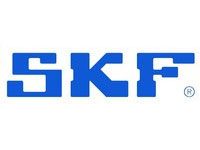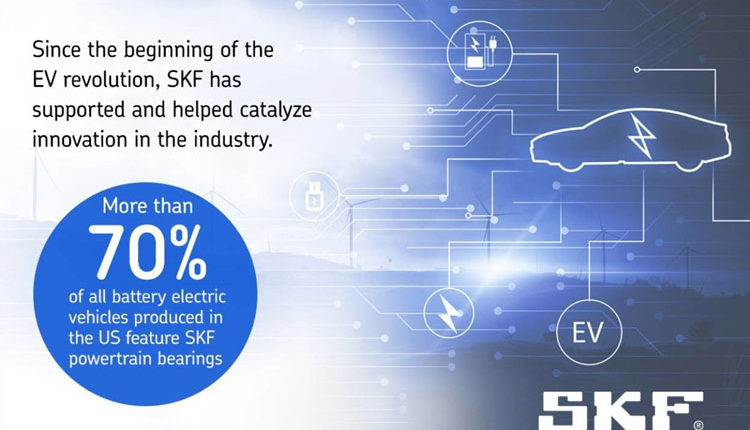SKF Technologies Critical in Helping Automakers Accelerate Electric Vehicle Development & Production
Company's Capabilities and Products Should Help Meet Growing Demand
 The revolution of the North American automotive industry is in progress with the growing demand for battery electric vehicles (BEVs), and SKF is well-positioned to support and advance the industry’s growth goals. BEV sales topped three million globally in 2020, a 40% year-over-year increase despite COVID challenges, with sales expected to reach 30 million vehicles by 2035. The BEV sector remains the fastest growing of the electrified technologies (by some distance), achieving 100% year over year growth from September 2020 to September 2021 according to LMC Automotive, a global auto industry consultant.
The revolution of the North American automotive industry is in progress with the growing demand for battery electric vehicles (BEVs), and SKF is well-positioned to support and advance the industry’s growth goals. BEV sales topped three million globally in 2020, a 40% year-over-year increase despite COVID challenges, with sales expected to reach 30 million vehicles by 2035. The BEV sector remains the fastest growing of the electrified technologies (by some distance), achieving 100% year over year growth from September 2020 to September 2021 according to LMC Automotive, a global auto industry consultant.
SKF is investing in EV technology as part of its pledge to increase sustainability. As part of their commitments to the Paris agreement on climate change, a growing number of countries are set to phase out the production of new combustion-engine vehicles over the next two decades. Around the world, the electrification of passenger transport is picking up momentum. Public opinion also enables major cities to start imposing bans or extra charges on fossil-fuel vehicles to improve local air quality.
In response to this growing demand and in alignment with the company’s stated goal of helping customers to become more sustainable, SKF is capitalizing on its decades of experience working in the EV sector and innovating products to improve EV performance and affordability. The company’s commitment to and expertise in the rapidly evolving market puts it at the leading edge of development for EV manufacturing.
“Our capabilities allow us to support the industry in overcoming challenges, while taking advantage of the many opportunities that EVs represent,” said Greg Zimmermann, President Automotive North America for SKF USA, Inc. “As technical advances like range extension, battery longevity, charging technology and available charging infrastructure continue to improve, the market will experience more competitive pricing attracting new buyers. And while cost reduction and more sustainable infrastructure will be important developments, the power density of BEVs will also continue to improve addressing range anxiety.”
Since the beginning of the EV revolution, SKF has supported and helped catalyze innovation in the industry. Automakers in North America choose SKF bearings as critical components in their electric drivetrains – with more than 70% of all battery electric vehicles produced in the US featuring SKF powertrain bearings. SKF’s work also includes developing tailored solutions to mitigate issues unique to EVs, including drivetrain damage resulting from electric current, hybrid bearings to improve performance, and other pain points of the EV customer.
“Electric vehicle power transmission may be mechanically simpler than their combustion-transmission counterparts, but building an efficient, reliable and enjoyable electric drivetrain is extremely challenging,” said Zimmermann. “Although the number of bearings is about the same in an EV axle compared to a traditional one, the technical challenge is more difficult due to higher rotational speeds and demanding conditions on the bearings used in EV transmissions.”
SKF addressed some of the challenges unique to EVs by redesigning the bearings and their components, such as the polymer cage, rolling components and by using special lubricating grease. In fact, customized and hybrid bearings are already solving some of the fundamental issues that can affect reliability in electric vehicles.
Specialized SKF EV Products include:
- Hybrid Deep Groove Ball Bearings (DGBB): SKF hybrid Deep Groove Ball Bearings (DGBB), for example, use ceramic rolling elements and steel rings. Bearings of this type offer improved high-speed performance and best-in-class electrical insulation characteristics, making them the premium choice for high performance EV powertrains. SKF offers tailored solutions to mitigate current leakage at the system level and to protect the entire EV transmission.
- eDrive Ball Bearings: The SKF eDrive ball bearing range features an energy-efficient polymer cage, an optimized raceway geometry, and a validated long-life wide-temperature grease. SKF eDrive ball bearings are designed for electric and hybrid vehicle drivetrains. The bearings deliver several design and performance benefits, including lower friction and lower friction variation, higher electric machine efficiency, power density and improved battery reliability.
- SKF Rotor Positioning Bearing: SKF’s Rotor Positioning Bearings are an integral component of the starter-alternator. The automotive industry is under constant pressure to reduce CO2 output and improve vehicle fuel efficiency. One way of doing this in micro-hybrid vehicles is to use a starter-alternator, which provides a stop-start function. This turns off the engine when the vehicle stops, then restarts it quickly when the driver releases the brake or engages a gear.
- SKF Needle Roller Bearing: Needle roller bearings have cylindrical rollers that are small in diameter. In spite of their low cross-section, they have a high load-carrying capacity and are therefore suitable for bearing arrangements where radial space is limited.
- NUBS cage for deep groove ball bearing: When alternators and starter motors undergo a cold start, this is often accompanied by a squealing sound. This problem, which tends to happen at random, but very rarely, can also affect the function of the electric traction motor. This can be solved with SKF’s specially designed Non-Uniform Balls Spacing (NUBS) cage.
- Sensor bearing units: SKF’s compact, robust and reliable, simple and ready-to-mount sensor bearing units are used to monitor the status of rotating or linear components accurately. Sensor-integrated solutions engineered by SKF have been well proven in electric vehicles.
- High Speed Ball Bearing: The SKF High Speed Ball Bearing 1.8 (HSBB 1.8) is able to reach a rotational speed of 30,000 rpm. This enables car manufacturers to increase the rotational speed of their electric motors to have higher efficiency and thus greater mileage between charges.
- Bi-Directional High-Speed Seal: This next-generation low friction seal is developed specifically for e-drive units with bi-directional sealing capability. With higher linear speed up to 50 m/s and low frictional torque, the seal is compatible with various eMobility transmission fluids.
In addition to product development work, the SKF North American Technical Center in Plymouth, Michigan, also supports car makers in application-specific engineering. One area of particular interest for the BEV market is noise and vibration. EVs are quieter than conventional cars, and even small amounts of noise in the powertrain are noticeable. SKF has worked with leading international automakers to identify the sources of these noises and address them through bearing and system level design to improve the outcome.
Application-specific engineering and close cooperation with customers at the early phase of the electric powertrain development also allows SKF to design high-efficiency bearing solutions and arrangements in order to decrease overall system power losses, therefore maximizing EV range.
EV manufacturers also require supply chains and engineering capabilities that fit well with their manufacturing and product development footprint. SKF has adopted a full-value-chain approach by investing in product development, manufacturing and testing to target local EV markets.
“The global footprint for SKF matches the customer footprint. We work hard to make sure our products are where our customers need them when they need them. In today’s world, SKF recognizes that our manufacturing and engineering capabilities need to be globally available to help meet customer demand,” said Zimmermann.
LMC Automotive expects electric vehicles to make up 34.2% of new U.S. vehicle sales by 2030, with all-electric at 30.1% and plug-in hybrids at 4.1%. SKF has the technical, manufacturing and supply-chain capabilities needed to support the sector’s accelerating growth.


